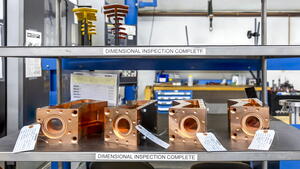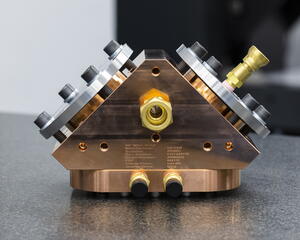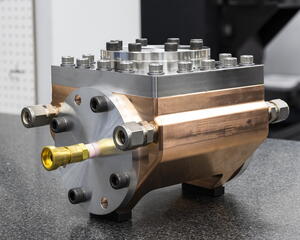US ships first electron cyclotron transmission line components
The US Domestic Agency is supplying the transmission lines that will provide efficient power transfer between the 170 GHz gyrotron sources of the electron cyclotron heating system and launchers situated in tokamak port plugs. Following years of design and prototyping, the first elements have left the production line and are on their way to ITER.
The technology that the United States is delivering is part of the broader electron cyclotron resonance heating system, which helps both initiate and control the plasma by delivering high-intensity beams of microwave radiation using a unique range of power, pulse length, and microwave frequency.
Electron cyclotron transmission lines—built from 10 main components including waveguides, switches, bends, couplings and bellows—will carry the high-intensity beams hundreds of metres between the radiofrequency sources and vacuum vessel port plugs. A major challenge of designing and procuring the system is to ensure that minimal power losses, or microwave mode changes, occur along the length of the transmission lines.
With the shipping of two of the system’s components this month to the ITER site—miter bends and expansion units fabricated by ARMEC Corp. in Oak Ridge, Tennessee—the US ITER electron cyclotron team has reached a milestone.
“After completing design and prototyping, we are finally at the point where we have proven the United States’ manufacturing capability for ITER’s electron cyclotron system,” said Ben Hardy, team manager of the US ITER Plasma Heating Systems group. “It is a realization of all our team’s efforts to date. We have built our relationships with private industry, overcome technical challenges, and now are shipping our first components to the ITER site.”
The impact on the private fusion industry in the United States has been significant, Hardy said.
“Our US ITER team’s contributions and industry partnerships have led to the development of world-leading, precision manufacturing capability that is laying the groundwork for the burgeoning fusion ecosystem in the United States. The impact on the private fusion industry can be significant because integrated fusion systems need readily made, high-performing heating technology solutions to remain competitive in the race to commercial fusion energy.”
Industry contributors from around the United States have fabricated prototypes, provided specialized materials, or are now manufacturing components. “The manufacturers we’ve worked with have gained experience fabricating first-of-a-kind fusion-energy components, often with challenging tolerances and unique materials,” said Greg Hanson, a senior physicist who has been a part of the US ITER project for 14 years.
One example is the engineering of evacuated aluminum waveguides with internal corrugations that can transmit 1.2 megawatts per line, while minimizing power transfer losses to 10% or less over an average of 140 meters per line. Other engineering challenges have included qualifications of the mirrors needed in the miter bends and precision welding for unique materials such as copper chromium zirconium.
Besides the wave guides and miter bend assemblies, system components provided by the United States include pumpouts, expansion units, direct current breaks, switches, and other specialized elements. Smaller parts number in the thousands – including the 20,000 coupling bolts needed for assembly.
Fusion technology is also being advanced by the team’s efforts in the modelling, simulations, and analysis needed for an electron cyclotron system at an industrial scale, which is documented in published papers.
“Our design calculations are for a 20-year operating run with reliability, operability, and maintenance considerations—something that had never been done before for electron cyclotron heating for fusion at industrial scale,” said Hanson, who has authored several dozen journal articles and research papers on the team’s work.
As deliveries from ARMEC continue, the team’s next steps include fabricating and delivering fully assembled direct-current breaks, switches, and adapters that ensure vacuum-tight connections between matching optics units and transmission lines. Additional ongoing work involves completing the final assembly of the waveguide first article and the testing and fabrication of the tenth and final major prototype component—the polarizer miter bend.
Electron cyclotron technology is one of 12 hardware systems that the United States is providing to ITER.




